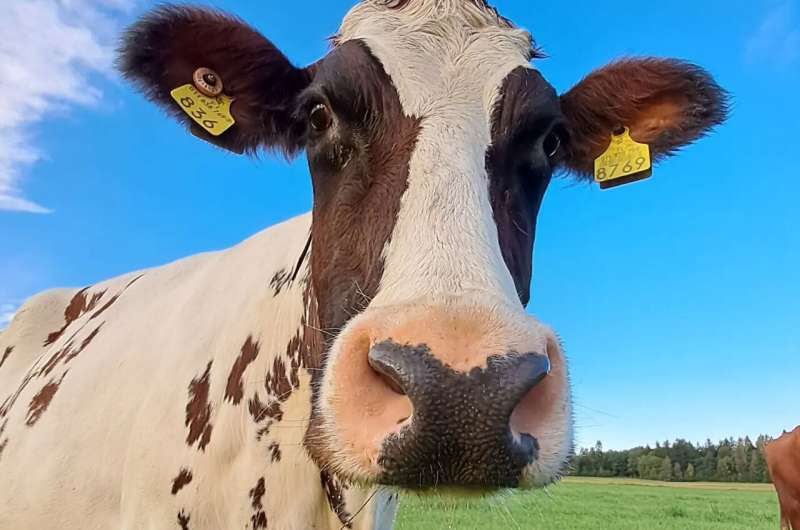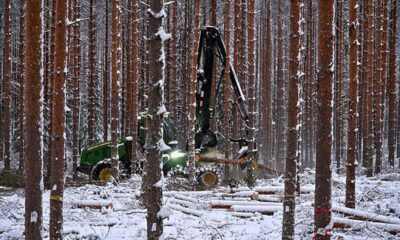Science
Microplastics Disrupt Farm Animal Gut Health, Study Finds

Microplastics, tiny particles widely found in agricultural settings, have been shown to disrupt the gut microbiome and fermentation processes in farm animals, according to a comprehensive study conducted by researchers from several prestigious institutions, including the University of Helsinki and the University of Zurich. This study, published in the Journal of Hazardous Materials on November 26, 2025, marks a significant step toward understanding the biological impacts of microplastic exposure on livestock.
Lead researcher Daniel Brugger, an Associate Professor of Companion and Monogastric Production Animal Nutrition at the University of Helsinki, emphasized the necessity of further research. “There is an urgent need for in-vivo studies to better understand the impacts on animal health and food safety, especially as global plastic production continues to rise,” he stated.
Key Findings on Microplastics and Rumen Health
The joint research involved a controlled laboratory fermentation system where cow rumen fluid was incubated with hay or barley alongside five prevalent types of microplastics: polylactic acid (PLA), polyhydroxybutyrate (PHB), high-density polyethylene (HDPE), polyvinyl chloride (PVC), and polypropylene (PP). Researchers tested these microplastics in various sizes and doses to assess their effects on rumen fermentation and microbial activity.
The study revealed that all tested microplastics did not remain inert within the rumen. Instead, they interacted with the microbial ecosystem, leading to significant changes in fermentation dynamics. For instance, the presence of microplastics consistently reduced cumulative gas production, a critical indicator of fermentation activity, across all plastic types and doses.
Moreover, total dry-matter disappearance increased with the addition of microplastics, indicating that not only feed but also parts of the plastic mass were broken down during fermentation. This process potentially reduced microplastic sizes, increasing their risk of tissue penetration.
In barley-based incubations, researchers noted a shift in microbial activity, with proteins associated with stress responses increasing while those involved in carbohydrate and amino-acid metabolism decreased. These findings suggest that microplastics disturb normal microbial metabolism, and certain microplastics may be partially degraded into smaller fragments by rumen microbes.
Implications for Agriculture and Food Safety
This research addresses a critical gap in understanding how microplastics function within the digestive systems of farm animals. Previous studies confirmed that livestock are exposed to microplastics through contaminated feed and soil, but it was unclear whether these particles remained unchanged or interacted with the microbiome.
Jana Seifert, a Professor of Functional Microbiology of Livestock at the University of Hohenheim, highlighted the study’s significance: “Our study shows for the first time that microplastics do not simply pass through the digestive tract of farm animals. Instead, they interact with the gut microbiome, alter fermentation processes, and are partially broken down.”
The implications of these findings are considerable. A stressed and less efficient microbiome could adversely affect animal health and productivity. Additionally, the formation of smaller plastic fragments during digestion may increase the likelihood of absorption into animal tissues, potentially entering the human food chain. This risk could be particularly pronounced in younger or stressed animals with more permeable intestinal barriers.
Researchers have called for improved management strategies to mitigate microplastic contamination in agricultural contexts, particularly concerning silage films, packaging materials, and sewage sludge used on fields.
“Plastic pollution isn’t just an environmental issue ‘out there.’ It has direct biological consequences for farm animals, and potentially for humans, through the food chain,” noted Cordt Zollfrank, a Professor of Biogenic Polymers at the Technical University of Munich.
The findings of this study not only enhance the scientific understanding of microplastic interactions with the rumen microbiome but also provide essential groundwork for future risk assessments. Regulatory bodies, veterinarians, and the feed industry now have experimental evidence indicating that microplastics interact with the rumen microbiome and are partially transformed.
As the implications of this research unfold, it paves the way for future investigations into microplastic interactions in non-ruminant species, such as pigs, which still require further testing. The ongoing dialogue surrounding agricultural practices and plastic usage will be crucial in ensuring the safety and health of livestock and, by extension, the quality of the food supply chain.
-

 Technology4 months ago
Technology4 months agoDiscover the Top 10 Calorie Counting Apps of 2025
-

 Health2 months ago
Health2 months agoBella Hadid Shares Health Update After Treatment for Lyme Disease
-

 Health3 months ago
Health3 months agoErin Bates Shares Recovery Update Following Sepsis Complications
-

 Technology4 weeks ago
Technology4 weeks agoDiscover 2025’s Top GPUs for Exceptional 4K Gaming Performance
-

 Technology2 months ago
Technology2 months agoElectric Moto Influencer Surronster Arrested in Tijuana
-

 Technology4 months ago
Technology4 months agoDiscover How to Reverse Image Search Using ChatGPT Effortlessly
-

 Technology4 months ago
Technology4 months agoMeta Initiates $60B AI Data Center Expansion, Starting in Ohio
-

 Technology4 months ago
Technology4 months agoRecovering a Suspended TikTok Account: A Step-by-Step Guide
-

 Health4 months ago
Health4 months agoTested: Rab Firewall Mountain Jacket Survives Harsh Conditions
-

 Lifestyle4 months ago
Lifestyle4 months agoBelton Family Reunites After Daughter Survives Hill Country Floods
-

 Technology3 months ago
Technology3 months agoUncovering the Top Five Most Challenging Motorcycles to Ride
-

 Technology4 months ago
Technology4 months agoHarmonic Launches AI Chatbot App to Transform Mathematical Reasoning

















